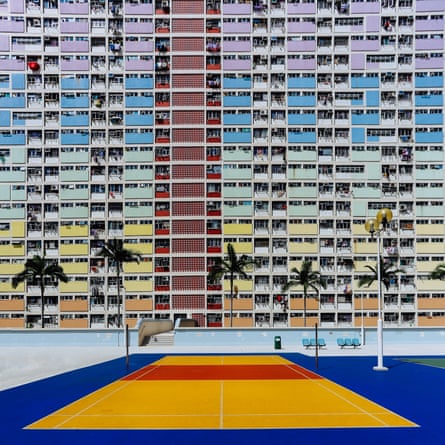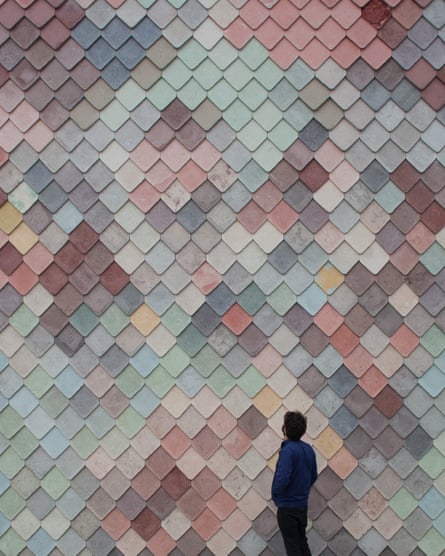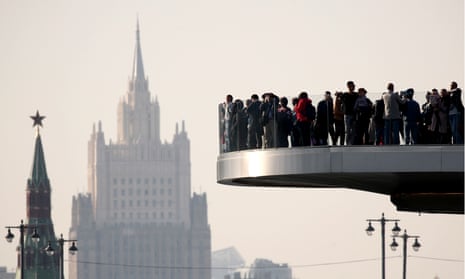For a couple of recent summers, gaggles of young Chinese tourists would regularly find themselves lost in an industrial estate on the edge of the A11 dual carriageway in east London, smartphones in hand, in search of the perfect selfie. The faded warehouses of Newham have their own special charm, but the millennials weren’t here to sample the post-industrial wastes of the 2012 Olympic site’s hinterland. They were here to find a wall.
Not just any old wall, but one that had been photographed and shared online thousands of times, that had found its way into the background of music videos and adverts, a patterned backdrop that had become so popular on social media that it had spawned a wave of unofficial merchandise.
“It was quite a surreal time,” says Maria Lisogorskaya of architecture collective Assemble, which had erected a big wooden shed in the yard of its Stratford studio in 2014, and clad it with a jolly facade of pastel-coloured cement tiles. Little did they know it would become an Instagram sensation, listed on a Chinese blog as the most Instagrammable wall in London, and inspire a torrent of knock-off goods for sale on Taobao, China’s online marketplace. Their sugary shingle pattern can now be found plastered across everything from purses to rolls of wallpaper; last year, I even stumbled on it on an iPhone cover in a street market in Hong Kong.
“We briefly looked into having our own phone covers made,” Lisogorskaya adds, “but when we contacted a manufacturer they told us it was an old design – they had already produced it two years ago.”
The famous selfie wall was dismantled in 2016, when Assemble relocated its studio to Bermondsey. But, thanks to the archive of geo-tagged photos, people can still occasionally be found wandering the hard shoulder of the A11.

This architectural Insta-fame was an accident for Assemble. But the social media platform, now counting 800 million users – more than a tenth of the world’s population – has since grown to become one of the most influential forces in the way our environments are being shaped. For a place to be shared on Instagram is no longer a chance by-product of a photogenic design, but a primary concern that drives the ambitions of clients and designers. The idea of “doing it for the ’gram” has moved from the preserve of Like-hungry teens to board meeting discussions and multimillion pound budgets.
Architect David Tickle, of global mega-firm Hassell, first became aware of the phenomenon while presenting a design in a competition for a new public square in Sydney. “One of the judges said he really liked our scheme because it was ‘highly Instagrammable’,” he recalls. “We hadn’t designed it with that in mind, but we realised that the stacked layers of terraces that we had proposed lent itself well to … social moments that could be captured and shared. We joked about it then, but it’s now become part of our vocabulary and an important way that we think about projects.”

Instagram is having an increasingly visible influence on the kind of work being commissioned to adorn our cities’ streets and squares. The immense popularity of public sculptures such as Anish Kapoor’s Cloud Gate in Chicago, a mirror-polished bean that reflects visitors and the surrounding skyline in a warped bulge, has led other cities to seek similarly sharable spectacles, in which the viewers themselves become an integral part of the artwork, placed centre stage in a piece of constructed scenography.
Thomas Heatherwick’s Vessel, an elaborate $200m staircase to nowhere, currently under construction in New York’s Hudson Yards, is an archetypal piece of shareable design. Billionaire real-estate developer Stephen Ross wanted an iconic bauble that would become a tourist magnet – an “Eiffel Tower for New York”, as he put it.
Roughly the shape of a 46 metre-high goblet, as wide as it is high, the Vessel’s proportions will fit nicely into Instagram’s square frame, while its multiple landings and polished copper soffits will offer innumerable shareable moments.
New York’s own purveyors of spectacle, Diller Scofidio + Renfro (architects of The Shed), have discovered the power of Instagram from experience. They have always had a thing for the photogenic wow factor, from engulfing a building in a cloud of mist to crafting Los Angeles’s Broad museum with the camp drama of a Disney ride (which has paid off: a quarter of visitors to the Broad say they decided to go there after seeing pictures on a friend’s social media feed). But never was the Instagram imperative so explicit in their work as in a recent project in Russia. Their winning design for Moscow’s $480m Zaryadye Park – a thrilling cocktail of floating bridges, undulating canopies and crystal caves – has flooded social media since it opened last year, perhaps distracting park-goers from posting about the Kremlin across the road.
This article includes content provided by Instagram. We ask for your permission before anything is loaded, as they may be using cookies and other technologies. To view this content, click 'Allow and continue'.
Configuring buildings and public spaces as selfie sets may well work for tourism promotion and the buzz of a launch, but once the novelty factor has worn off, the whimsy can grate and the flimsiness become all too apparent. The urge for quick, affordable spectacle often leads to stick-on, paper-thin cladding materials that look good in photographs, but weather terribly. The stained, peeling facades of the last decade stand as a grim testament to prioritising photographability over function.
Social media-savvy mayors and their city marketers should be careful of the unintended consequences of online popularity, too. Some of the world’s most Instagrammed locations have become unbearable selfie-scrums. A fight broke out this year in Rome, when two tourists battled over the perfect selfie spot at the Trevi fountain, leading the city to enforce a single-file policy at the famous site. In Hong Kong, unlikely locations have been inundated, from social housing estates to industrial ports. Residents of the pastel-hued Choi Hung social housing estate are getting increasingly frustrated by the hordes of Instagrammers flocking to take pictures on their colourful basketball courts. At another photogenic estate in the city, residents have taken matters into their own hands, hanging signs warning visitors not to take photos without prior permission. Meanwhile, the forklift truck drivers of a busy cargo pier in Sai Wan are finding themselves having to weave in and out of groups of selfie-snappers, who flock to the newly christened Instagram Pier to pose in front of shipping containers, pallets and piles of bamboo, with the skyline of Victoria Harbour in the background.
The primacy of Instagram has spawned an entire industry of social media design consultancies, advising clients how to make their designs as sharable as possible. After working on resorts in Asia, Australian architect Scott Valentine decided to write an Instagram design guide. It details different ways to conjure “a visual sense of amazement”, encouraging restaurant and hotel owners to create spaces “in which your guests themselves can take centre stage”. The impulse is not just to make something photogenic, he says, but to create a scene in which a person can place themselves – to be photographed, liked and shared.
“We had been working in the hospitality industry in Bali, where every single venue wanted to be in the ‘top nine tiles’ of Instagram,” Valentine says, referring to the first images that pop up on the app for any given location. “The priority was always to have a feature wall for people to take pictures of themselves in front of, whether it was a mural of angel wings or an interesting collection of found objects.”
In Dubai, corporate firm Stride Treglown has followed its client’s Instagram-conscious brief to the letter. “The key was to make sure the design incorporated hashtags,” says practice director Robert Sargent, of the Rove hotel. “We considered where people would be wanting to take Instagram pictures and put the hashtag there: etched on the mirrors, on bedroom walls, in big cutout letters outside the hotel.” #RELAX shouts a sign in the lobby. “This is where I am,” notes a sign above the bed. The resulting vibe is more like the office of a San Francisco start-up. The walls are covered with motivational messages, along with a sign urging guests to “create memories” – and perform some free advertising for the hotel chain in the process.
This article includes content provided by Instagram. We ask for your permission before anything is loaded, as they may be using cookies and other technologies. To view this content, click 'Allow and continue'.
Instagram has had one of its biggest impacts on the retail sphere. In an era when the internet is accused of sounding the death-knell for high streets, the photo sharing app is giving a new lease of “experience-driven” life back into stores. For Nike in Shanghai, branding agency Rosie Lee constructed an elaborate throne structure, where visitors could be photographed ensconced at the top of a huge transparent chair filled with trainers. For another project, they had to install filters over the lights just before opening because someone noticed that the harshness of the lighting, while good for the products, made it harder for visitors to get a good picture of themselves.
It’s not just youth-oriented brands that have caught the bug. Architect Farshid Moussavi, who recently completed a fit-out for Harrods’ toy department, is working on a new section with a brief to make it Instagram-friendly, after the shop noticed how often people posed for photos with its life-sized teddy bears. At first she was sceptical, but she now says that this social media-driven approach is positive because it highlights “that these environments are not just containers for storing goods or providing services. Instagram is reinforcing the fact that space matters, which can only be good news for designers and architects.”

She also points to a wider relaxation of rules around photography in museums and galleries. The V&A has gone from displaying signs prohibiting photography and sketching to putting social media at the heart of its plans, encouraging people to share their pictures with the hashtag #myvam. One museum insider says the competition for this year’s V&A Christmas tree installation was judged chiefly through the lens of how it would perform on Instagram.
It is easy to despair that the influence of social media is reducing the designer’s role to providing jazzy backdrops and quirky props, flattening the world into a selfie stage set. The recent appearance of a pop-up Selfie Factory in Shoreditch – a saccharine “funhouse” of ball pits, confetti rooms and doughnut walls, calibrated for the sole activity of taking photos of yourself – might make you think the end is nigh. The feeling of doom is perhaps only matched by the fact that one major architecture practice recently installed a swing in a show apartment for a luxury residential development, after their client was concerned it didn’t have enough Instagram allure.
But could our obsession with capturing and sharing also represent an opportunity for innovation? Shouldn’t architects be welcoming a platform that encourages people to look more closely at their surroundings? Sam Jacob, designer of the forthcoming Cartoon Museum in central London sees no cause for concern. “It’s merely an extension of the ‘Kodak moment’, or those seaside cut-out boards where you put your head through a hole,” he says. “Architects have always designed their buildings to be photogenic. Someone who worked on the Barbican told me that they exaggerated the rough concrete surface and the contrasting white tiles, so it would look better in the high-contrast black and white photography of the day.”
As for our selfie obsession, he adds, architecture has a long tradition of being specifically designed to frame people. “It’s exactly what a church or a cathedral does; this is a sort of democratic version of it. And it’s a good challenge: Instagram culture moves so fast and gets exhausted so quickly that you have to keep evolving your architectural language, whether in drawings, models or actual buildings.”
Perhaps we should be thankful that architects have embraced Instagram – if only because it brought us a vision of Norman, Lord Foster of Thames Bank, floating on a giant inflatable unicorn.

Comments (…)
Sign in or create your Guardian account to join the discussion